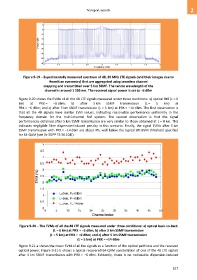Page 627 - 5G Basics - Core Network Aspects
P. 627
Transport aspects 2
Figure 9-19 – Experimentally measured spectrum of 48, 20 MHz LTE signals (and their images due to
Hermitian symmetry) that are aggregated using seamless channel
mapping and transmitted over 5 km SSMF. The centre wavelength of the
channel is around 1 550 nm. The received signal power is set to −6 dBm
Figure 9-20 shows the EVMs of all the 48 LTE signals measured under three conditions: a) optical BtB (L = 0
km) at PRX = –6 dBm; b) after 5 km SSMF transmission (L = 5 km) at
PRX = −6 dBm; and c) after 5 km SSMF transmission (L = 5 km) at PRX = −14 dBm. The first observation is
that all the 48 signals have similar EVM values, indicating reasonable performance uniformity in the
frequency domain for the multi-channel RoF system. The second observation is that the signal
performances obtained after 5 km SSMF transmission are very similar to those obtained at L = 0 km. This
indicates negligible fibre dispersion-induced penalty in this scenario. Finally, the signal EVMs after 5 km
SSMF transmission with PRX = −14 dBm are about 4%, well below the typical 8% EVM threshold specified
for 64-QAM (see [b-3GPP TS 36.104]).
Figure 9-20 – The EVMs of all the 48 LTE signals measured under three conditions: a) optical back-to-back
(L = 0 km) at PRX = −6 dBm; b) after 5 km SSMF transmission
(L = 5 km) at PRX = −6 dBm; and c) after 5 km SSMF transmission
(L = 5 km) at PRX = −14 dBm
Figure 9-21-a shows the mean EVM of all the signals as a function of the optical path loss and the received
optical power. Figure 9-21-b shows a typical recovered 64-QAM constellation of one of the 48 LTE signals
after 5 km SSMF transmission with PRX = −6 dBm. Evidently, there is no noticeable dispersion-induced
617

